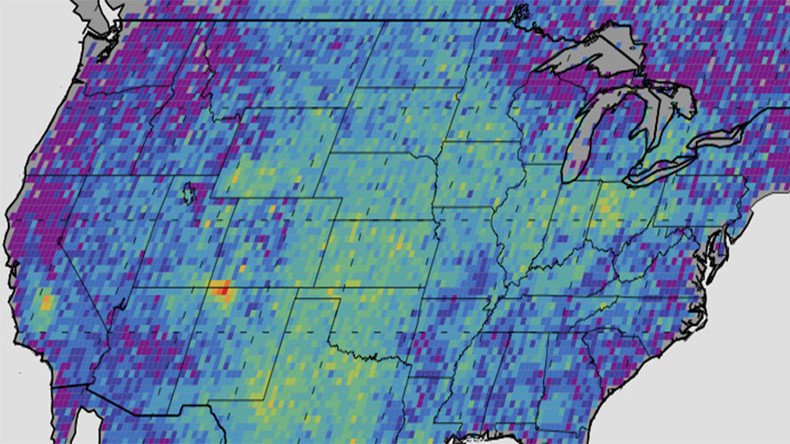Fracking leaks a major factor in US methane 'hot spot' – NASA

Using airborne thermal infrared spectrometers, a NASA-led team has found 25 leaks due to fracking natural gas production are contributing two-thirds of the methane emissions in a hot spot in the United States’ Four Corners region.
Using two airborne spectrometers flying 3,000 to 10,000 feet above the ground, researchers identified and measured more than 250 individual sources leaking methane plumes in the Four Regions region of Arizona, Colorado, New Mexico and Utah. The majority of leaks are from gas wells, storage tanks, pipelines and processing plants used in hydraulic fracturing, or fracking, operations for natural gas.
“The sources emitted the gas at rates ranging from a few pounds to 11,000 pounds (5,000 kilograms) per hour,” NASA said in a statement.
Study says 10% of methane sources in Four Corners region of US contribute 1/2 the emissions: https://t.co/wor4GevaOSpic.twitter.com/qy98EJKVQi
— NASA (@NASA) August 15, 2016
The study said as much as two-thirds of the methane could be spewing from only about 25 locations.
Only a handful of the 250 leaks were caused by natural seepage from underground formations, and one was a vent from a coal mine, according to researchers with NASA’s Jet Propulsion Laboratory and the California Institute of Technology.
“Where we saw the biggest anomalies from space, that’s where we put our target area,” said Christian Frankenberg, lead author of the study.
#Methane hot spot over Southwestern US is mostly from natural gas production leaks, NASA study finds. https://t.co/VnzHNaVgDl
— Dan Elliott (@DanElliottAP) August 15, 2016
Frankenberg said the scientists might have missed some plumes that were too slight to be detected by sensors, and other sources might be intermittent, detected on some days but not others.
Ground teams followed up the survey by visiting some of the methane sources and recording emissions using special cameras. They contacted the operators of two pipelines after detecting leaks and the operators made repairs, according to the study.
Researchers didn’t identify the operators of the leaking fracking facilities in most cases because they usually weren’t aware of specific locations until they were analyzing the data after the flights.
Methane leaks undermine climate benefits of natural gas. Eerie @Earthworks videos illustrate https://t.co/IN69hSTR5opic.twitter.com/2uMjdTcXyD
— Frontier Group (@FrontierGroupUS) August 15, 2016
Natural gas is primarily composed of methane. It is a greenhouse gas that traps heat in Earth’s atmosphere and warms it. It is the third most abundant greenhouse gas behind water vapor and carbon dioxide. Denser than carbon dioxide, scientists are interested in how methane concentrations may be changing. There is a national debate under way over whether and how much methane should be regulated.
North Dakota pipeline leaks crude oil, 3mn gallons of #fracking byproduct http://t.co/5so0d1brmTpic.twitter.com/os4gDHuXnF
— RT America (@RT_America) January 23, 2015
More than half of atmospheric methane comes from human-related sources such as livestock, landfills, and leaks of natural gas into the atmosphere during mining, storage, transportation and distribution.
The study’s findings were published this week in the Proceedings of the National Academy of Sciences in a paper titled Airborne methane remote measurements reveal heavy-tail flux distribution in Four Corners region.











